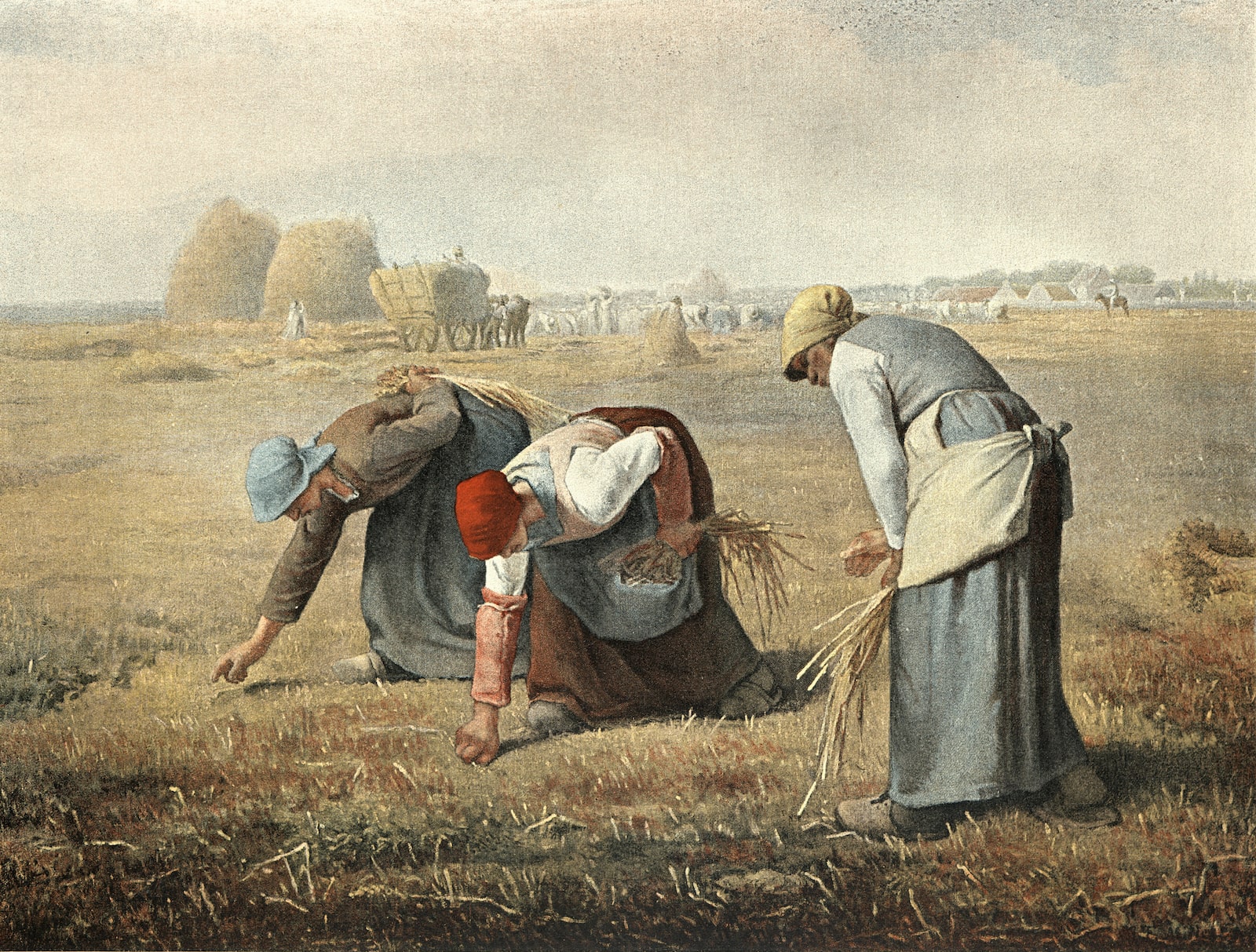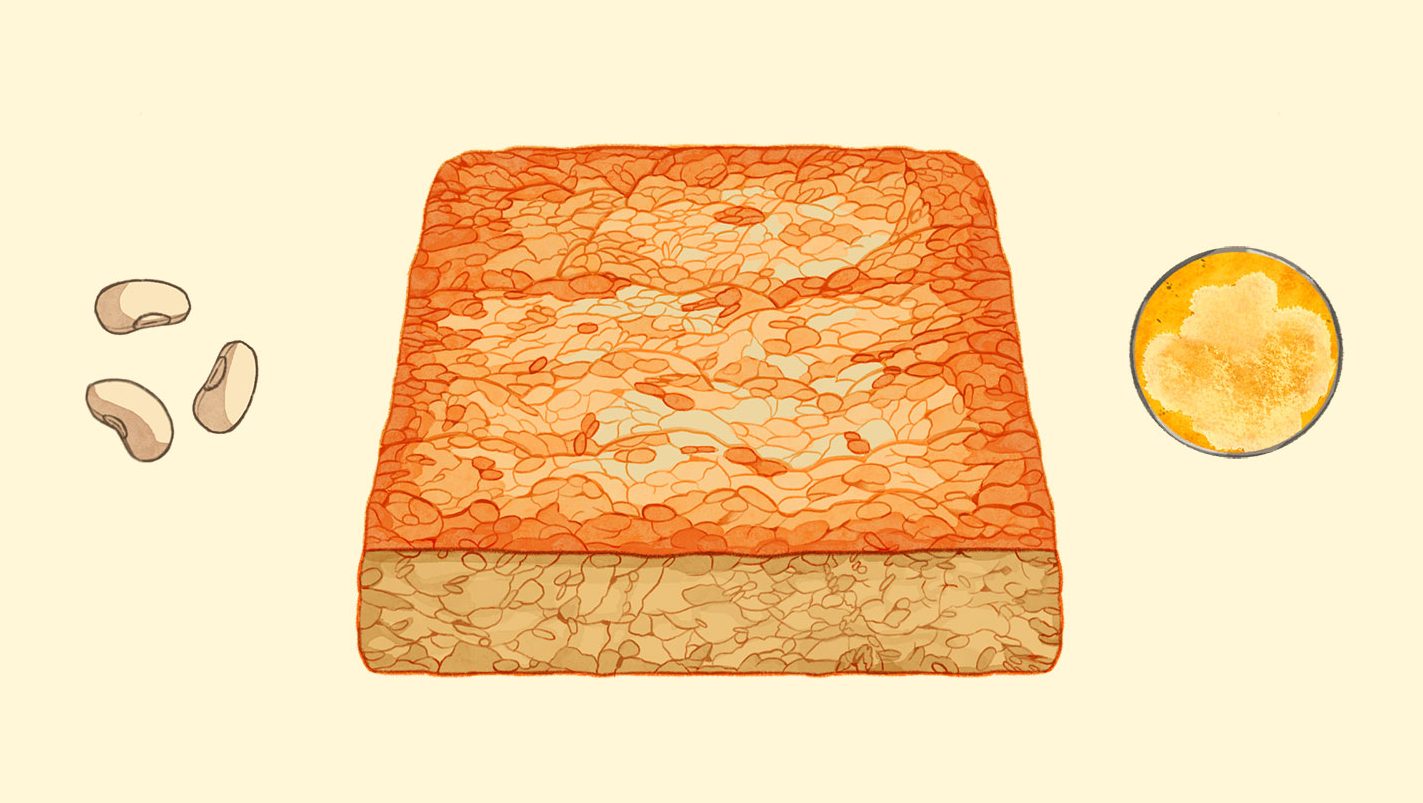The three women in the painting stoop low in the field, their hands reaching for leftover stalks of wheat. Their bent figures dominate the foreground, emphasizing the physical toll of their labor. Jean-François Millet’s The Gleaners, painted in 1857, immortalized this act of necessity: gleaning, the collection of leftover crops after the harvest. Rooted in agrarian traditions, the term originates from the Old French glener and the Latin glennare, meaning “to gather.” For centuries, gleaning had been a lifeline for the rural poor in England and France — a legally recognized right that allowed them to enter fields after the harvest to collect what remained. French law enshrined it as a civil right in 1554, while in England, it was an unspoken agreement that reflected the feudal system’s delicate balance between the privileged and the poor.
But by the late 18th century, this precarious equilibrium began to unravel. The forces of privatization and industrialization swept through England, as Enclosure Acts transformed common lands into private property, barring access for the poor. In 1788, the landmark court case Steel v. Houghton shattered the custom of gleaning as a right, reclassifying it as trespass. Mechanization soon followed, with threshing machines and combine harvesters leaving less behind for gleaners to collect. By the mid-19th century, gleaning had faded into memory, a relic of premodern agrarian life overtaken by the relentless march of progress.
And yet, Millet’s scene depicting the work of gathering what others have left behind is playing out once again — not as a relic, but as a response to the crises of food waste and poverty. In a potato field in Cornwall, England, volunteers sift through wooden crates, separating the good from the bruised, while others cut kale, filling sacks with leaves destined for community kitchens.

Getty Images
“We’re feeding quite a lot — about 10,000 people a week,” said Holly Whitelaw, the founder of Gleaning Cornwall. “It might just be a couple of bits of vegetables, but it’s something healthy.” The operation, run with the help of over 400 volunteers, relies on a patchwork of coordination via the online messaging platform WhatsApp, donated storage spaces, and sheer determination. Yet, Whitelaw notes, it’s far from enough: “Big funding is needed to really do this properly. The need is increasing.”
At a time when 3.3 million metric tons of food are wasted annually on U.K. farms, the environmental and social costs of inaction are staggering. Rotting food releases methane, a greenhouse gas that is far more potent than carbon dioxide, and the resources used to grow that food — water, energy, and land — are wasted along with it. Tristram Stuart, the historian and activist who co-founded the Gleaning Network in 2011, of which Gleaning Cornwall is a part, envisioned the practice as a way to challenge British food waste at its source. Today, from Kent to Birmingham, gleaning groups are not just picking up produce but picking apart the unsustainable norms that allow waste to persist in the first place.
The impact of this waste goes far beyond the visible rot in fields. Globally, nearly a third of all food produced is never eaten, and in the U.K., unharvested crops contribute an estimated 6 billion metric tons of carbon dioxide equivalent annually — 11 percent of the country’s agricultural emissions. Across the Atlantic, the problem plays out on an even larger scale. Laurie Beyranevand, the director of the Center for Agriculture and Food Systems at Vermont Law and Graduate School in the U.S., highlights the strain on natural resources caused by overproduction.
“Here in the States, we’ve got mega farms out West using precious water resources during droughts to grow food that never makes it into the supply chain,” she said. “People say, ‘Oh, it’ll get tilled back into the soil,’ but that doesn’t account for the resources wasted in the process — pesticides, labor, energy — all of it has environmental costs.”
Across the U.K., gleaning has become a critical tool in the fight against food waste and poverty. Groups like the Sussex Gleaning Network organize teams to collect everything from carrots to cauliflowers, redistributing the rescued food to food banks and community projects like FareShare Sussex, which takes good-quality surplus food and provides it to people in need. The Gleaning Network as a whole has collaborated with over 60 farmers and 3,000 volunteers to save more than 500 metric tons of fruits and vegetables, ensuring that surplus produce is delivered quickly and safely to those who need it most.
For Phil Holtam, the regional programs manager of Feedback Global, an organization that pushes for a more sustainable food system, the process begins long before harvest day. “We recruit a team of volunteers and hire a van in advance,” he explained. “On the day, we meet at the farm around 10 a.m., go over health and safety, and then get to work.” Once the produce is picked, it’s rushed to cold storage facilities to preserve its freshness. “Gleaning volunteers can pick more in a day than a kitchen can process in a week,” Holtam added, underscoring the scale of both the problem and the solution. For the volunteers in the fields, the work is urgent. And for the families they serve, it’s a lifeline.
Food waste starts at the very source: the farm. Up to 16 percent of a crop can be wasted due to factors completely out of a farmer’s control. “Supermarkets reject produce for being too wonky, too small, or the wrong color,” said Sussex-based Holtam. “Then there’s unpredictable weather, labor shortages — it’s endless.” What’s left in the fields — potatoes, kale, courgettes (zucchini), soft fruit — represents a staggering waste of resources and an urgent environmental crisis.
The solutions offered by gleaning are both practical and symbolic. Gleaners rescue food that would otherwise contribute to methane emissions in landfills or decompose in fields. They work with farmers to ensure that what can’t be sold is turned into a resource for the community. “We’ve worked with everything from soft fruit to salad greens, clearing beds and keeping crops out of the compost heap,” said Holtam. “It’s about turning potential waste into community resources.”

Leon Neal / Getty Images
Yet, for all its impact, gleaning is still a stopgap measure. As Beyranevand points out, the root problem is systemic. “Farmers are forced to overgrow to meet strict supermarket contracts, only to see tons of perfectly good food rejected because it doesn’t meet cosmetic standards.” The solution lies, she said, in creating secondary markets for surplus produce and reducing the overproduction that forces farmers to rely on donations to move their crops.
Until that systemic shift occurs, the gleaners persist — crouching in fields, filling crates with overlooked crops, and salvaging what they can. Every potato pulled from the ground, every courgette packed into a crate, every small effort, is a quiet victory.
While the idea is simple — rescue food that would otherwise go to waste — that work takes different forms around the world. In the U.K., organizations like Gleaning Network UK run structured operations, coordinating volunteers to collect surplus crops from farms and deliver them to food banks. In the U.S., gleaning is often smaller scale, led by grassroots groups and church volunteers.
“It’s very much driven by philanthropy, and the groups are often disconnected,” said Beyranevand, who has worked with several gleaning organizations in the country. Without a centralized system, efforts rely on personal relationships with farmers and ad hoc coordination, making the process inconsistent and resource-dependent.
Legal and cultural differences also shape these approaches. In the U.K., farmers generally welcome gleaners, while in the U.S., stricter property laws and liability concerns create barriers. “Farmers worry about what happens if someone gets injured,” Beyranevand explained. Although some states have introduced protections, these laws are inconsistent, and food safety concerns add further complexity. Maryland, for example, has enacted specific laws to protect farmers from liability when they allow gleaners onto their land, providing a model for how legislation can encourage participation while addressing farmers’ concerns.
Despite its promise, gleaning alone cannot fix systemic issues of food waste and insecurity. Beyranevand calls it a reactive solution, dependent on surplus or rejected crops. “Ultimately, wouldn’t it be wonderful if we didn’t need gleaning at all?” she asked. Some organizations, like Boston Area Gleaners in the U.S., are exploring proactive approaches, such as acquiring farmland to grow crops specifically for food banks. But scaling such initiatives requires significant investment and structural support.
Still, gleaning is about more than just rescuing food — it’s about rediscovering the value of what we’ve overlooked. For Kelly LeBlanc, vice president of nutrition programming at Oldways, a nonprofit that inspires people to embrace the healthy and sustainable joys of the old ways of eating, the significance goes beyond food itself. “We’re starting to recognize that diets better for people are better for the planet as well,” she said. “The simple act of turning discarded crops into nourishment bridges so many divides — between nutrition and sustainability, between waste and renewal.”
Perhaps that’s gleaning’s greatest gift: its ability to remind us that even in a world of abundance, there is beauty in what’s left behind. Jean-François Millet’s painting The Gleaners immortalized this truth nearly two centuries ago, and today, it’s no less poignant.
This story was originally published by Grist with the headline Gleaning: The ancient practice fighting modern food waste on Jan 24, 2025.
“The simple act of turning discarded crops into nourishment bridges so many divides.” Food and Agriculture Grist








